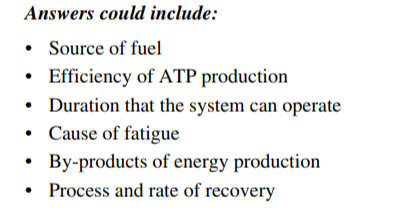This sample answer is a response to question 27 from the 2014 HSC PDHPE exam “Compare the two anaerobic energy systems.” worth 5 marks. The answer is provided by Melissa. As always, I encourage you to read through this answer and compare it to the sample answer provided by NESA along with the marking criteria (here and below). You should always be looking to critique sample answer and improve upon them.
The anaerobic energy system is for short, intense bursts of activity and doesn’t require large amounts of oxygen. The ATP/PC or alactacid energy system is usually the starting point of the activity as it kicks in quickly. Its source of fuel is creatine phosphate and its efficiency in producing ATP is very fast by limited to about 8-12 seconds. Its cause of fatigue is depletion of PC and ATP and produces heat as a by-product. Recovery involves restoring the PC which lasts 30 seconds to 2 minutes. Examples of sports using the alactacid energy system include 100m sprint and weightlifting. On the other hand, the lactic acid system kicks in after and its source of fuel is glycogen. It is slower in producing ATP than the alactacid energy system but is still fast, lasting 30 seconds to 3 minutes. Its cause of fatigue is Hydrogen ion buildup and produces pyruvic acid as a by-product. The process of recovery is the removal of pyruvic acid and its rate of recovery is much slower with 30-60 minutes. Examples include 200m sprint or 400m sprint.
For another sample answer, see my answer here.


For your chance to see your sample answers appear on the site, submit one via the form below.






